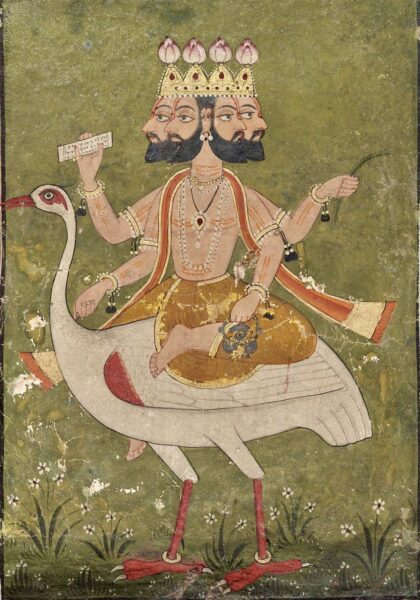
1. Somya, before this world was manifest there was only existence, one without a second. On this subject, some maintain that before this world was manifest there was only non-existence, one without a second. Out of that non-existence, existence emerged.
2. The father said: ‘O Somya, what proof is there for this—that from nothing something has emerged? Rather, before this world came into being, O Somya, there was only existence, one without a second’.
3. That Existence decided: ‘I shall be many. I shall be born.’ He then created fire. That fire also decided: ‘I shall be many. I shall be born.’ Then fire produced water. That is why whenever or wherever a person mourns or perspires, he produces water.
4. That water decided: ‘I shall be many; I shall be born.’ That water then created food. This is why whenever and wherever there is rain, at once food grows in great abundance. It is from water that food is produced.
Chāndogyopaniṣad
The mirror test is a psychological experiment designed to measure degree of self cognition, wherein a subject is marked with blot of paint and presented a mirror. If the subject touches the marked region the subject is deemed to possess a rudiment of self awareness. The emphasis on visual acuity notwithstanding, the mirror test has been used on variety of animals with varying levels of success. Significantly, toddlers, while exhibiting fascination with mirrors, do not appear to recognize their reflection until at least fifteen months. The onset of recognition in toddlers suggesting self cognition as a stage of human development. The mirror stage corresponding to the imaginary order, the recognition of self as separate—and cutoff from the world and the mother. The identification of self in the image amplifying the alienation from the real. A break rooted in the first utterance of the Word. The imaginary order marked by a demand for realization that is at once divorced from, and in tension with, the real. The unrealized image prompting corpus of desires that, hindered by the inability of language to articulate the raison d’etre, fail not only satisfy the demand but operate to further alienate one from the real.
BIBLIOGRAPHY: 1. Brahma. circa 1700. Watercolor on paper. Museum of Fine Arts, Boston. 2. Śaṅkarācāryaḥ, Ādi. Chandogya Upanisad - Translated with notes based on Shankara's commentary. Translated by Swami Lokeswarananda, Calcutta: Ramakrishna Mission Institute of Culture, 1998. 3. Felluga, Dino F. Critical Theory: the Key Concepts. New York: Routledge, 2015. Print. 4. Lévi-Strauss, Claude. The Naked Man: Mythologiques, Volume 4. Chicago : The University of Chicago Press, 1990. [Myths] teach us a great deal about the societies from which they originate, they help to lay bare their inner workings and clarify the raison d'etre of beliefs, customs and institutions, the organization of which was at first sight incomprehensible, …[and] they make it possible to discover certain operational modes of the human mind, which have remained so constant over the centuries, and are so widespread over immense geographical distances, that we can assume them to be fundamental and can seek to find them in other societies and in other areas of mental life, where their presence was not suspected, and whose nature is thereby illuminated.